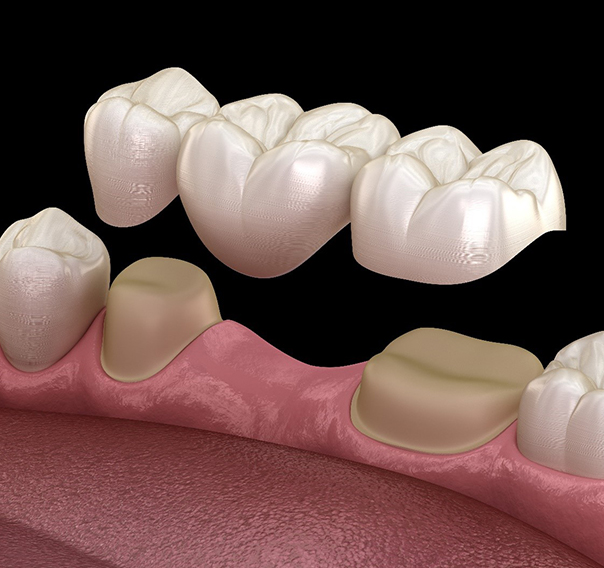
About dental bridges
A dental bridge serves as a reliable and permanent solution for replacing missing teeth. Unlike removable partial dentures that attach to existing teeth, a dental bridge relies on crowns affixed to neighboring teeth or dental implants. This restoration not only restores the appearance and function of a natural smile but also prevents teeth from shifting and maintains proper bite alignment.
The concept of a fixed dental bridge dates back thousands of years and has been used throughout ancient civilizations. Various materials such as animal and human teeth, bones, gold, and ivory were employed to fill gaps in smiles.
Fortunately, dental materials and technology have evolved significantly over time. Modern dental bridges are now crafted from high-quality materials like porcelain, porcelain fused to metal, and engineered ceramics such as zirconia. These bridges are not only stronger and more durable but also provide a more aesthetically pleasing appearance, offering a natural and attractive look.
Common types
Traditional fixed bridge
A traditional fixed bridge typically involves preparing and crowning teeth on both sides of the empty space in the mouth. These crowned teeth serve as support for the artificial teeth, known as "pontics," which fill the gap. Similar to a bridge over water relying on sturdy pillars at each end, a dental bridge gains strength and stability from the crowned teeth fused to one or more pontics.
On the other hand, a cantilever fixed bridge, though similar in appearance to a traditional fixed bridge, differs significantly. In this design, only one side of the pontic is connected to a crown for support.
Implant-Supported Bridges
Dental implants are an advanced solution for replacing missing teeth, closely resembling the appearance, feel, and function of natural teeth. An implant-supported bridge is often the preferred choice as it removes the necessity to involve or prepare adjacent natural teeth.
Functioning similarly to natural tooth roots, dental implants offer crucial support for a bridge. Implant-supported bridges provide a versatile method to restore a complete smile, as strategically positioned implants can support any number of replacement teeth. Additionally, dental implants help prevent bone shrinkage caused by tooth loss, maintaining normal facial contours.
At Lakeview Family Dentistry, our goal is to help every patient achieve exceptional oral health and a beautiful smile. We deliver skilled and experienced care, utilizing advanced dental implant-based solutions to transform incomplete smiles into confident ones that not only look fantastic but also function exceptionally well.
What to expect when getting a traditional bridge
The process of creating fixed bridges typically involves several visits to ensure precision and effectiveness. This step-by-step procedure includes preparing the supporting teeth, obtaining impressions, placing a temporary bridge, and finally, cementing the permanent restoration.
Initially, a comprehensive diagnostic workup is performed to create an appropriate treatment plan. For patients opting for a traditional fixed bridge, the next step involves preparing the abutment teeth for full-coverage crowns. Depending on the number of teeth involved, an impression for the permanent bridge may be taken during this visit or the next one. Meanwhile, temporary crowns or a temporary bridge are fitted to protect the prepared teeth.
After teeth preparation, some sensitivity and gum soreness may occur, which usually diminish over time. However, temporary restorations might not offer the same precise fit as the final permanent crown or bridge, potentially leading to sensitivity until the treatment is completed.
It's crucial to handle temporary restorations with care as they are not as durable as permanent ones. If your temporary bridge sustains damage or becomes dislodged, it's important to keep it safe and promptly contact our office for a replacement appointment. Attempting self-repairs is not recommended.
Before cementing the new bridge, we conduct a thorough examination of the shade, contours, fit, and occlusion. Once everything is confirmed, the permanent restoration is placed. As you have been wearing a temporary restoration, you might notice a slight difference in your bite and feel some pressure as the new restoration establishes proper contact with the adjacent teeth. If any discomfort persists or if your bite feels off after a few days, please contact our office, as a minor adjustment may be necessary.
What to expect when getting an implant-supported bridge
The procedure for placing dental implants is generally considered an outpatient surgical process, the complexity of which depends on the type and quantity of implants required, as well as any additional procedures necessary to prepare the supporting bone.
As your committed healthcare partner, our focus is on keeping you well-informed throughout the entire process. To ensure precise placement of your implant-supported bridge, we will gather detailed diagnostic records, including 3D images of your jaws and the specific area targeted for the implants.
In our practice, patient care and comfort are paramount. We strive to ensure that every visit to our office is comfortable and stress-free. Before moving forward with the dental implant placement, we will discuss anesthesia options and dental sedation, offering comprehensive pre-operative and post-operative care instructions.
After the dental implants are placed to support your bridge, several months may be necessary for them to fully integrate with the surrounding bone. In some cases, a temporary bridge can be placed on the same day to provide immediate aesthetic satisfaction. However, the permanent bridge is typically installed once complete healing and fusion with the surrounding bone have occurred.
